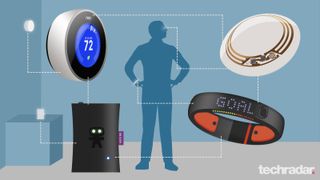The Internet of Everything is coming: Are you ready?
Let's connect

The scope of the Internet of Things (IoT) is huge. Internet-connected devices are growing exponentially. The number of devices that the typical enterprise worker uses sometimes outnumbers the user 8:1, with the average non-enterprise consumer not far behind.
Because of this paradigm, organizations are investing heavily in an effort to leverage the IoT and bring new productivity tools and solutions to market.
For example, by using intelligent location-based services and connected shopping carts, innovative store chains can send customers reminders when they leave items behind and offer coupons to help close the sale. Building management companies can increase tenant satisfaction and cut maintenance costs by collecting data from connected heating and A/C systems that track utilization and proactively react and adjust based on this data.
Challenges
While the Internet of Things can improve user experiences and bring new innovations for in-office workflows and consumers, it also brings new challenges. Performance, network availability, usability and security are critical points of consideration.
Questions arise concerning how data collected from endpoints in the IoT is used. For IoT applications, there may be hundreds of thousands to millions or tens of millions of heterogeneous devices with differing session establishment and flow placement needs – bandwidth and network performance are not infinite.
While these challenges may be more easily taken on by mega web scale providers, the typical company that wants to either deploy internal or customer-facing applications to take advantage of the Internet of Things will face new architectural, data handling and network considerations.
The complexity of IoT development and the required wireless technology means that new methodologies, software and hardware have to be carefully integrated. Today's IT infrastructures are segmented, which works counterintuitively toward a core principle of IoT, as it is a seamless interconnection of nodes, sensors and machines that can interact real-time across boundaries.
Are you a pro? Subscribe to our newsletter
Sign up to the TechRadar Pro newsletter to get all the top news, opinion, features and guidance your business needs to succeed!
All of this results in complexity and a long road to true integration. Moreover, many technology business leaders are equally driving their teams to investigate other technologies such as SDN and NFV and you can wind up with a confused infrastructure that breeds solutions looking for problems.
Getting ready to connect
The best way to be ready for the IoT and any new technology for that matter is to evaluate the actual business problems that exist and explore how these new architectures can help. For bleeding edge tech, the best way to do this is by incrementally carving out time and resources to be exploratory and introduce new things into the mainstream progressively.
The Internet of Things is still in the early stages of development at this time. Much like cloud, SDN, NFV, and an innumerable amount of previously new technology waves, there will continue to be innovation, but there will also be some confusion. Fortunately, the benefits and applications are real.
New applications and ways of interacting as well as gathering and using data are being developed in this sharing-driven economy. Embracing IoT will bring benefits to organizations, their employees and their customers in ways previously not possible.
For IT leaders, moving from an internal return-on-investment selling strategy to one that focuses on return-on-vision will likely work best in getting the needed backing to move their efforts forward, providing the fuel for the IoT to deliver more integrated solutions and services that will shape the future of the Internet.
- Ray Downes is the CEO of KEMP Technologies

Intel unveils flurry of new Arc GPUs — however serious graphics users will have to wait for more powerful models, as these focus on a completely different and more lucrative market

WD launches enormous 4TB SD card for creative pros — smashes world record for largest removable memory card to smithereens at twice the capacity of biggest microSD cards
Most Popular




